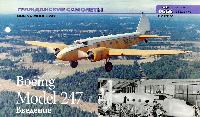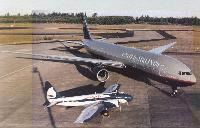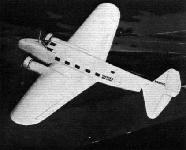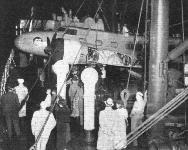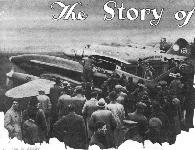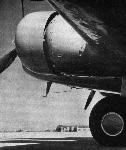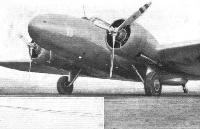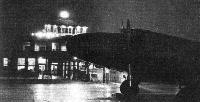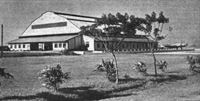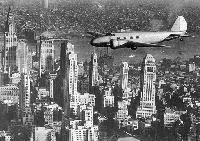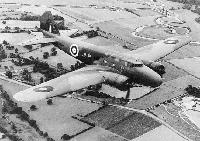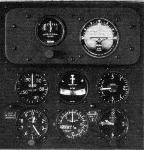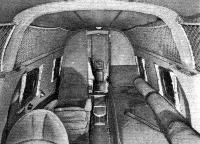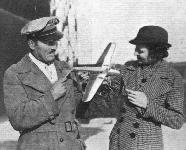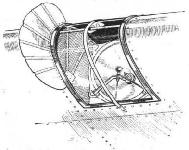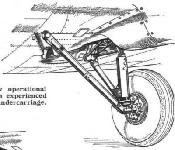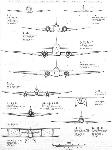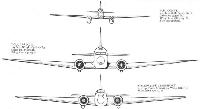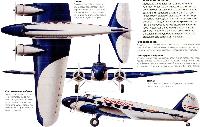
Boeing Model 247
8 февраля 1933 года фирма "Boeing" подняла в воздух прототип нового авиалайнера, получившего обозначение Boeing Model 247. При компоновке этой машины группа конструкторов использовала аэродинамические и конструктивные решения самолетов Model 200 и Model 215.
Model 247 считался прототипом современного авиалайнера, представляя собой обтекаемый моноплан цельнометаллической конструкции с низкорасположенным свободнонесущим крылом, силовой установкой из двух двигателей и колесным шасси с убираемыми основными стойками. Он также имел закрытую кабину для двух пилотов, стюардессы и 10 пассажиров. Самолет мог взлететь с полной нагрузкой и поддерживать высоту полета даже при одном работающем двигателе. К тому же в его компоновке присутствовали новые элементы гражданского транспортного самолета, а именно пневматические антиобледенительные устройства на передних кромках крыла и хвостового оперения.
60 машин Model 247 были заказаны фактически прямо "с чертежной доски" для переоснащения авиакомпании "Boeing Air Transport System", ставшей незадолго до того основным отделением "United Air Lines". Еще 15 машин заказали другие компании и частные лица. Самолеты, построенные для Роско Тернера и Клайда Пангборна для участия в авиагонках Макробертсона в 1934 году по маршруту Англия - Австралия, были оснащены дополнительными фюзеляжными топливными баками вместо стандартного оборудования пассажирского салона, обтекателями двигателей типа NACA, снижающими лобовое сопротивление, и винтами изменяемого шага для улучшения летных характеристик. Эти улучшения позже использовались на большинстве Model 247, доведя их до стандарта Model 247D, который включал в себя также сдвигаемый назад, а не вперед фонарь кабины пилотов.
С вступлением США во Вторую мировую войну в декабре 1941 года 27 самолетов Model 247D использовались авиацией Армии США под обозначением C-73. Предполагалось, что они могут служить для перевозки грузов и личного состава, но оказалось, что двери его пассажирской кабины слишком узкие. Вместо этого C-73 использовались для переброски летных экипажей, а позже для обучения. В ходе эксплуатации они были переоснащены звездообразными двигателями Pratt & Whitney R-1340-AN-1 мощностью 600 л. с. (447 кВт). В конце 1944 года самолеты вернули на гражданские авиалинии.
ТАКТИКО-ТЕХНИЧЕСКИЕ ХАРАКТЕРИСТИКИ
Boeing Model 247D
Тип: гражданский транспортно-пассажирский самолет
Силовая установка: два звездообразных двигателя Pratt & Whitney SI HI С Wasp мощностью по 550 л. с. (410 кВт)
Летные характеристики: максимальная скорость 322 км/ч на оптимальной высоте; крейсерская скорость 304 км/ч на высоте 2440 м; начальная скороподъемность 351 м/мин; практический потолок 7740 м; дальность полета 1199 м
Масса: пустого 4148 кг; максимальная взлетная 6192 кг
Размеры: размах крыла 22,56 м; длина 15,72 м; высота 3,60 м; площадь крыла 77,68 м-
Нагрузка: до 10 пассажиров и 181 кг почты
Описание:
- Boeing Model 247
- Flight, August 1932
A NEW BOEING TRANSPORT PLANE - Flight, October 1934
THE SUCCESSFUL MACHINES - Flight, November 1934
THIRD IN THE SPEED RACE
Фотографии
-
Мировая Авиация 55
Регистрационный номер: NC13326 [2] Model 247D, окрашенный в цвета компании "United" конца 1930-х годов. Тогда этот тип самолета в больших количествах использовался различными авиакомпаниями. 247-й ознаменовал собой большой шаг в развитии коммерческой авиации, дав значительное увеличение скорости и предоставив пассажирам невиданный ранее уровень комфорта. Но конкуренты тоже не дремали, и вскоре "Douglas" начала выпускать самолеты большей вместимости, с аналогичными удобствами и равной скоростью, которые вытеснили Model 247.
-
Авиация и Космонавтика 2013-10 / В.Морозов - Великая воздушная гонка
Регистрационный номер: NR257Y [9] Боинг-247D
-
Jane's All the World Aircraft 1980 / Encyclopedia of Aviation - Aircraft A-Z - v2
Регистрационный номер: N3977C [2] Boeing Model 247.
-
Мировая Авиация 46
Регистрационный номер: N3977C [2] Этот Model 247, бывший сельскохозяйственный самолет для опыления полей, был восстановлен Тихоокеанским фондом истории авиации. В настоящее время его окраска соответствует времени нахождения в составе UAL.
-
Мировая Авиация 55
Регистрационный номер: NC13347 [7] После войны самолеты Model 247 в течение многих лет использовались мелкими авиакомпаниями в основном для перевозки грузов. Машина на снимке применялась для опыления полей до 1978 года, а затем ее передали на реставрацию.
Boeing Model 247 (30 March 1933). -
Air International 1993-02 / G.Jones - Swallow to Airbus
Регистрационный номер: NC13347 [7] Revolutionary when it appeared, the Boeing 247 was ordered by UAL, 59 of the first 60 being completed for the airline. This preserved example carries the early grey colour used by all UAL aircraft until 1940 when the scheme was changed to blue and white.
-
Air International 2002-06 / R.Whitford - Fundamentals of Airliner Design /Commercial/ (9)
Регистрационный номер: NC13347 [7] When it was first introduced in 1933, the revolutionary Boeing 247, seen here, came without variable-pitch propellers. Shortly afterwards, as the single Douglas DC-1 was taking shape, it became clear that it would be substantially heavier than originally estimated. It would thus not be able to meet single-engine take-off requirements unless variable-pitch propellers were installed.
-
Air Enthusiast 2007-03 / E.Davies - Boeing's Airline /Airlines and airliners/ (2)
Регистрационный номер: NC13347 [7] -
Aeroplane Monthly 1999-10 / T.Harmsworth - Over the Moon and under the 'Kosh /Oshkosh '99 report/
Регистрационный номер: NC13347 [7] The Museum of Flight brought its Seattle-based Boeing 247, NC13347, the only surviving airworthy example, down to Oshkosh for the first time. This was its longest flight since it was returned to airworthiness in 1994.
-
Мировая Авиация 202
Регистрационный номер: NC13347 [7] 7 июня 1995 года "United Airlines" первой в мире начала эксплуатацию Boeing 777, первый самолет компания получила 15 мая. "United" была партнером "Boeing" по разработке 777-го, это помогло конструкторам понять и решить многие проблемы эксплуатации авиалайнеров. При участии "United" на 777-м оптимизировали систему жизнеобеспечения, багажные полки салонов и даже отделку интерьера. На фотографии 777-й стоит рядом с пассажирским Boeing Model 247, который считается первым пассажирским самолетом современной компоновки.
The Museum of Flight's Boeing 247D provides scale to a United Airlines 767 - 53 years separate the first flights of their prototypes.Другие самолёты на фотографии: Boeing Boeing 777 - США - 1994
-
Мировая Авиация 9
Регистрационный номер: NC13301 8 февраля 1933г.: Первый полет Boeing Model 247, первого американского двухмоторного цельнометаллического пассажирского моноплана.
-
Air Enthusiast 2003-07 / K.Ellis - Seattle showcase
Регистрационный номер: NC13300 The one-off Model 247A NC13300 of 1933 was used for trials and as a corporate transport for Pratt & Whitney/United Aircraft.
-
Air International 1987-03 / R.Braybrook - The Sixties, the Thirties and the American Challenge
Continuing to demonstrate its world lead in the design of economically superior airliners, the US industry produced such types as the Boeing 247D (shown) and Douglas DC-2.
-
Flight 1933-11 / Flight
SIXTY OF THEM IN SERVICE: A striking night photograph of one of the United Air Lines' new three-mile-a-minute Boeing 247 transports, halting briefly at Salt Lake City in the course of a Coast-to-Coast flight of less than 20 hours. All 60 of the new Boeings ordered by United, now are in regular service on the company's Coast-to-Coast, Pacific Coast, and other routes.
-
Flight 1932-08 / Flight
The new Boeing Air Transport, an all-metal low-wing monoplane fitted with two 550-h.p. "Wasp" engines.
-
Aeroplane Monthly 1982-11 / Boeing 247D N18E /Preservation Profile/
Регистрационный номер: N18E [5] Probably at Sandusky, Ohio. 1968
-
Aeroplane Monthly 1982-10 / P.Jarrett - Grapevine
Регистрационный номер: N18E [5] The Science Museums newly acquired Boeing 247, N18E photographed shortly after its arrival at Wrought on.
-
Aeroplane Monthly 1982-11 / Boeing 247D N18E /Preservation Profile/
Регистрационный номер: N18E [5] -
Aeroplane Monthly 1982-11 / Boeing 247D N18E /Preservation Profile/
Регистрационный номер: N18E [5] On arrival at Wroughton, August 3. 1982
-
Aeroplane Monthly 1982-11 / Boeing 247D N18E /Preservation Profile/
Регистрационный номер: N18E [5] At Miami in 1954 after fitting of Wasp engines
-
Мировая Авиация 55
Один из 27 Model 247, использовавшихся ВВС США под обозначением C-73 с двигателями Wasp военного образца, двухлопастными винтами и капотами от учебного самолета North American AT-6 Texan.
-
Мировая Авиация 46
Регистрационный номер: X13301 [2] Прототип Model 247 после доработки до стандарта 247E с полностью закапотированными двигателями, скошенным назад лобовым стеклом и другими усовершенствованиями.
-
Авиация и Космонавтика 2013-10 / В.Морозов - Великая воздушная гонка
Регистрационный номер: NC13369 По окончании гонки Роско Тернер возвратил свой Боинг-247D авиакомпании "Юнайтед Эйр Лайнз". Там все рекламные надписи были удалены, а самолет получил новый регистрационный номер NC-13369 и эмблему компании. Зато рядом с ней на фюзеляже появилась карта со схемой гонки. В 1953 г. самолет был передан в Национальный авиационный музей
-
Мировая Авиация 55
Регистрационный номер: NR257Y [9] Самый известный Model 247, бывший самолет авиакомпании "United", принимал участие в гонках на приз Макробертсона от Лондона до Мельбурна. На фюзеляже нанесен логотип "57 Varieties", принадлежавший спонсору - продуктовой компании "Heinz".
-
Flight 1934-10 / Flight
Регистрационный номер: NR257Y [9] The Boeing Transport (two Pratt & Whitney "Wasps") piloted by Roscoe Turner and Clyde Pangborn.
-
Flight 1934-10 / Flight
Регистрационный номер: NR257Y [9] THIRD TO ARRIVE IN AUSTRALIA: The Boeing 247-D (2-S1H1-G "Wasp"), taxying in at Mildenhall after flying over from Martlesham Heath, where it had been weighed.
-
Авиация и Космонавтика 2013-10 / В.Морозов - Великая воздушная гонка
Регистрационный номер: NR257Y [9] Кинохроникеры снимают "Боинг-247D" перед отлетом из США в Англию
-
Flight 1934-10 / Flight
Регистрационный номер: NR257Y [9] A FIRST-CLASS PASSENGER: An England-Australia competitor arrives in England. The Boeing 247-D monoplane, Comet, which Clive Pangborn and Roscoe Turner will fly in the race, on board the liner Westerland at Southampton on October 7.
-
Flight 1934-10 / Flight
Регистрационный номер: NR257Y [9] ZERO HOUR: The crowd watches the competitors line up. In the foreground is the unlucky Mollisons' "Comet," and behind it Col. Roscoe Turner's Boeing.
Zero hour, and competitors are lined up at Mildenhall for the start of the race. The Mollisons' Comet is in the foreground; Roscoe Turner's Boeing 247 behind.Другие самолёты на фотографии: De Havilland Comet / D.H.88 - Великобритания - 1934
-
Flight 1934-10 / Flight
Регистрационный номер: NR257Y [9] "LET ME HELP!" Competition to give a helping hand with the crank of the inertia starter on the Boeing.
-
Flight 1936-04 / Flight
Much pioneer work has been done in the U.S.A. with the enclosing of geared and supercharged engines in long-chord cowlings. This view shows the mounting of one of the 550 h.p. Wasps in a Boeing 247-D.
-
Flight 1934-11 / Flight
An impressive view of the latest Boeing. N.A.C.A. cowlings have replaced the short-chord cowlings fitted to the 247 and three-bladed Hamilton-Standard airscrews are used.
-
Flight 1934-11 / Flight
The control cabin of the 247-D, showing the mounting of the wireless aerial, the normal screen and the sliding side window.
-
Flight 1934-11 / Flight
Регистрационный номер: NC13361 [2] The new Boeing 247-D has shown a marked improvement in performance on the 247. The engines are geared and supercharged nine-cylinder Pratt and Whitney "H" type "Wasps."
-
Aeroplane Monthly 1992-07 / D.Middleton - Propellers (1)
Регистрационный номер: NR257Y [9] ON TEST: Col. Roscoe Turner and Mr. Clyde Pangborn flying the Boeing 247-D on a test flight before shipping it to this country. The machine is now at Heston.
The first Boeing 247 airliner was fitted with fixed-pitched metal propellers. The aircraft’s performance was enhanced considerably with the fitting of VP units. -
Flight 1936-02 / Flight
NOCTURNE: One of the United Air Lines' Boeing 247 's in front of the terminal buildings at Burbank Airport, California - which is generally considered to be America's model airport.
-
Мировая Авиация 46
Регистрационный номер: X13301 [2] Первый самолет Model 247 вернули Boeing для испытаний, в результате чего появился 247D. Он летал с различными конфигурациями киля, затем его вновь передали авиакомпании - он стал единственным Model 247E. С началом Второй мировой войны самолет под обозначением C-73 перешел к ВВС США.
-
Flight 1936-07 / Flight
UBIQUITOUS: A D.H. Dragon Rapide, used by Canadian Airways on the daily Seattle-Vancouver service, parked in front of the administration building, Boeing Field, Seattle, Wash. An interesting feature of this Rapide is the increased fin area necessary when floats are fitted. The other machines will be recognised as a Lockheed Electra 10A of Northwest Airlines and a Boeing 247D of United Air Lines.
Другие самолёты на фотографии: De Havilland Dragon Rapide / Dominie / D.H.89 - Великобритания - 1934Lockheed Electra 10 - США - 1934
-
Flight 1939-08 / Flight
CANADIAN TERMINUS: Sea Island Airport, Vancouver, B.C., with one of Trans-Canada Air Lines' Lockheed Fourteens and one of United Air Lines’ old Boeing 247 Ds on the tarmac.
Другие самолёты на фотографии: Lockheed Super Electra 14 - США - 1937
-
Flight 1939-06 / Flight
COLOMBIAN CENTRE: A scene, pictorial rather than educative, at Mangar airport, Barranquilla, which is the base for the operations of the Colombian national company SCADTA. On the right of the picture is one of the four Boeing 247s used by the company.
-
Мировая Авиация 55
Регистрационный номер: NC13326 [2] Когда в 1930-х годах коммерческая авиация стремительно развивалась, авиакомпания "United" эксплуатировала два самых надежных самолета того времени: Douglas DC-3 (на заднем плане) и Boeing 247D. Но в конечном итоге Douglas вытеснил Boeing.
Другие самолёты на фотографии: Douglas DC-3 / C-47 Skytrain/С-53 Skytrooper / Dakota - США - 1935
-
Мировая Авиация 46
Регистрационный номер: D-AGAR Два Model 247 приобрела "Deutsche Lufthansa" - один из двух заказчиков машины (вторым была UAL). Салон, обладавший определенной комфортностью, вмещал 10 пассажиров.
-
Мировая Авиация 46
Model 247 мог продолжать набор высоты с одним работающим двигателем. Эта характеристика была важным аргументом для продажи машины авиакомпаниям, желавшим повысить безопасность пассажиров.
-
Мировая Авиация 64
Регистрационный номер: NC13361 [2] Model 247D (на фотографии) отличался от Model 247 цельным капотом двигателей и фонарем кабины, откидывающимся назад. Часть машин Model 247 была переделана до этого стандарта.
-
Мировая Авиация 46
Самолет, сфотографированный в полете над Нью-Йорком, с 1937 года по 26 октября 1945 года летал в составе UAL и использовался для изучения возможных новых маршрутов для авиакомпании, а также был учебно-тренировочным самолетом для подготовки пилотов.
-
Мировая Авиация 55
Этот 247D после эксплуатации в компании UAL и в Канаде был передан англичанам и стал первым самолетом фирмы "Boeing" в британских ВВС. Он использовался в Деффорде в исследованиях по созданию системы "слепой" посадки.
-
Air Pictorial 1957-11 / B.Robertson - U.S. Aircraft in the British Services 1914-1955 (9)
The Boeing 247D which was used by the R.A.F. throughout the war;
-
Aeroplane Monthly 1988-05 / ??? - And there's more where these came from...
The first Boeing 247 made its maiden flight in February 1933 and 60 of the 75 built were delivered to United Air Lines.
-
Мировая Авиация 46
Для Model 247 специалисты "Boeing" применили конструкцию с работающей обшивкой, значительно улучшившей аэродинамику самолета по сравнению с трехмоторными Ford. Носовой люк обеспечивал доступ к радиооборудованию и почтовому отсеку.
-
Air Enthusiast 2003-07 / K.Ellis - Seattle showcase
Регистрационный номер: NC13347 [7] Work underway on the restoration of MoF's 247D NC13347 at Paine Field, Everett, 1989.
-
Мировая Авиация 55
Регистрационный номер: NC13366 Вооруженный авиалайнер. Седьмой серийный Model 247D, поставленный UAL под номером NC13366, в январе 1937 был возвращен на завод и переоборудован в уникальный Model 247Y. Вместимость уменьшили до шести человек, дальность увеличили за счет четырех дополнительных топливных баков, снятых с самолета, участвовавшего в гонках на приз Макробертсона, в носовой части установили два курсовых пулемета калибра 12,7 мм (на снимке) и еще один пулемет на турели в задней части салона. Самолет был продан в Китай, но о цели его приобретения и о дальнейшей судьбе ничего неизвестно.
-
Flight 1937-08 / Flight
A typical American array of a few years ago, used on the Boeing 247s. Above is the Sperry free gyro panel, while below, from left to right, can be seen (top row) an A.S.I., a turn and bank indicator, and a rate-of-climb indicator, and (bottom row) a sensitive altimeter, a boost gauge, and a clock.
-
Jane's All the World Aircraft 1980 / Encyclopedia of Aviation - Aircraft A-Z - v2
Interior of a Model 247D.
-
Flight 1935-01 / Flight
AMERICAN LUXURY FOR THE EAST. A Boeing 247-D, with this special interior, has been delivered to Marshal Chang Hsueh Liang who is in charge of the Hupeh Province of the Nanking Government.
-
Flight 1940-04 / Flight
THE EQUIPMENT USED. The latest lightweight television transmitter installed in an aeroplane. It operates on a wavelength of 104 centimeters. Similar work has been done in this country, but has been kept secret.
-
Flight 1935-10 / Flight
A COMMUTING SHIP - or what we should know as a business man's aeroplane, is the Boeing 247D of the American Phillips Petroleum Company. Here an official of that company is seen using an inter-'phone RT set to talk to ground wireless stations. The equipment can be used, in addition, for communication between the cabin and the pilots' compartment.
-
Flight 1934-10 / Flight
AT MILDENHALL: Mr. Roscoe Turner, one of the favourites in the Great Race and third to reach Australia, exhibits a model of his Boeing 247 airliner.
-
Aviation Historian 7 / American Classics
Ray Milland goes over the blueprints while Andy Devine checks out the mockup cockpit for the new “Falconer Bomber” in Men With Wings (Paramount, 1938). The storyline follows a family from the early days of flight to the beginning of World War Two. Directed by William Wellman (whose Wings won the first Oscar), this Technicolor film contains some excellent flying scenes under the direction of Paul Mantz. The part of the Falconer Bomber was played by a Boeing 247 for the flying scenes, one of which includes a squadron of Boeing P-12s.
-
Flight 1934-10 / Flight
The installation of one of the landing lights in the Boeing 247-D, showing the neat method of screening.
-
Flight 1934-10 / Flight
The fuselage line blends into the trailing edge of the rudder on Roscoe Turner's Boeing. Of the two auxiliary surfaces in the rudder one is a "servo rudder" and the other a "tab" for trimming. Note also the "tab" in the elevator.
-
Flight 1934-10 / Flight
Very few operational failures have been experienced with the Boeing undercarriage.
-
Flight 1934-10 / Flight
Другие самолёты на фотографии: Airspeed Courier / AS.5 - Великобритания - 1933Airspeed Envoy / AS.6 - Великобритания - 1934Douglas DC-1 / DC-2 / C-32 / C-39 - США - 1933Fairey Fairey IIIF - Великобритания - 1926Koolhoven FK-41 - Нидерланды - 1928Lockheed Orion 9 - США - 1931Messerschmitt Bf.108 Taifun - Германия - 1934Miles Hawk / M.2 - Великобритания - 1932Pander S-4 Postjager - Нидерланды - 1933
-
Flight 1934-10 / Flight
BIG CLAUS AND LITTLE CLAUS: Front elevations, to the same scale, of the De Havilland "Comet," the Douglas D.C.2, and the Boeing 247-D. These machines were first, second and third respectively to reach Australia.
Другие самолёты на фотографии: De Havilland Comet / D.H.88 - Великобритания - 1934Douglas DC-1 / DC-2 / C-32 / C-39 - США - 1933
- Фотографии



